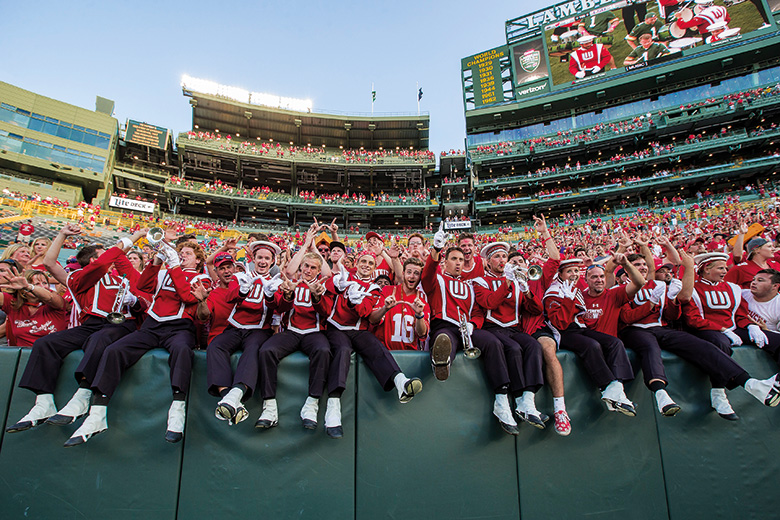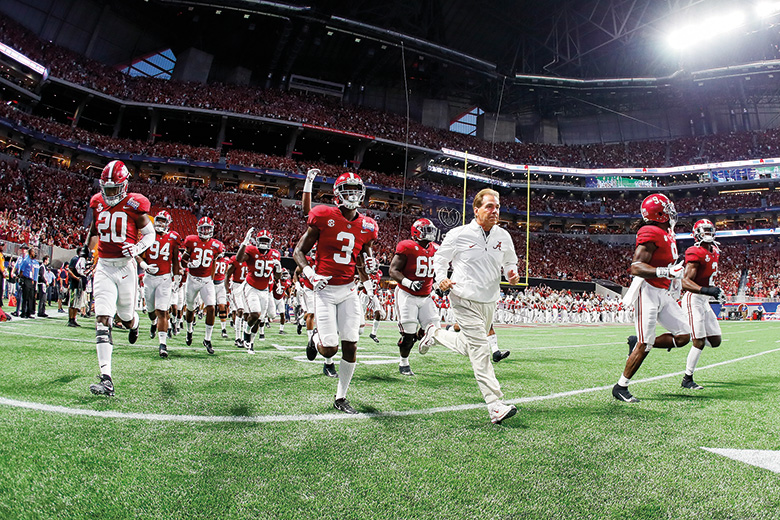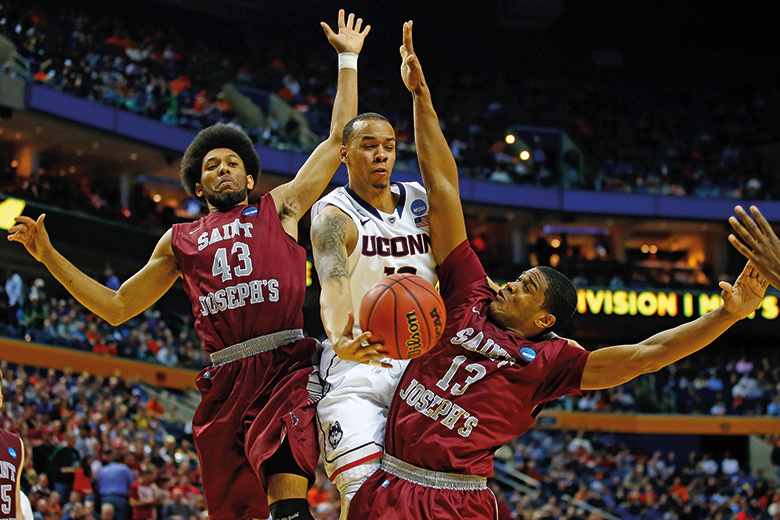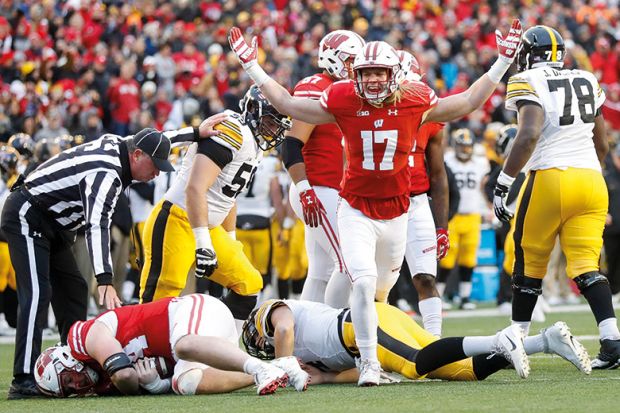A 300-piece marching band leads a parade of fire engines carrying high-spirited cheerleaders past a rapturous sea of more than 80,000 people, almost all of them in red and white. Some of these onlookers wander away from the bedlam to sit in the lap of a nearby statue of Abraham Lincoln, their whispered entreaties to the Civil War president drowned out by the music looping from restaurants and stores.
“On Wisconsin, on Wisconsin, stand up, Badgers, sing,” it blares, over and over. “Forward is our driving spirit, loyal voices ring/On Wisconsin, on Wisconsin, raise her glowing flame/Stand, fellows, let us now salute her name!”
It is football game day in Madison, the home town of the University of Wisconsin, and the pageantry amounts to a uniquely American tradition. The observance of the various rituals is almost religious: the playing of the university fight song, the wearing of its colours, the prayers for victory to Lincoln and the adulation for the Badgers mascot that is omnipresent on the merchandise being snapped up as quickly as sellers can give out the change.
University athletics is deeply woven into US culture and commerce, accounting for emotional loyalties and rivalries and billions of dollars in revenue, divided up among broadcasters, marketers, the universities themselves and highly paid coaches who also stand to earn lucrative endorsement revenue from sponsors.
“Spectators have become addicted to the spectacle, and the universities have swallowed hard and found ways to live with this pact with the devil,” says Jay Smith, a historian at the University of North Carolina who studies university athletics. “And for that reason, the system has become entrenched.”
But US university athletics is also facing yet another round of attacks after a long succession of ethical, financial and academic scandals, an uprising among players who want a share of all that money, and new financial realities that have stretched university budgets and diminished the willingness of non-athlete students to continue to subsidise athletics.
“These threats to the integrity of college sports are an urgent call to reform, if ever there was one,” says Arne Duncan, the former US secretary of education and co-chair of the independent Knight Commission on Intercollegiate Athletics, a panel mostly made up of university leaders and former college athletes, set up in 1989 in the wake of previous scandals and aimed at promoting academic integrity in college sports.
Even the powerful National Collegiate Athletic Association (NCAA), which oversees much of US university sports, has acknowledged that nearly 80 per cent of Americans in a survey it conducted said that universities put money ahead of the interests of their student athletes.
That all came into particularly conspicuous view this autumn. In September, the FBI charged 10 university coaches, agents and executives of the athletic apparel company Adidas with paying student athletes tens of thousands of dollars in bribes to steer them towards Adidas-sponsored teams, or to favoured financial advisers and agents who stood to make millions from them if they went professional. One of those institutions, the University of Louisville, had, just a year previously, been found to have provided prostitutes to teenage athletes it was hoping to recruit.
Then, in October, the NCAA – a membership association made up of the universities themselves – said that it largely lacked authority to penalise North Carolina for a nearly 20-year history of academic fraud, under which the university put thousands of student athletes into sham courses requiring little or no work but for which they were awarded high enough grades to keep them eligible to play. The NCAA’s oversight association said that it was up to member schools themselves to decide what constitutes academic fraud: a response that has been met with a predictably incredulous reaction.
All of this has pointed the glare of publicity away from the basketball courts and football fields encircled by riotous fans and towards university athletics programmes themselves. And the recent scandals are only the latest in a long line of high-profile own goals involving US university athletics programmes.
In 2016, for instance, Baylor University, a Baptist university in Texas, fired its head football coach for failing to respond to sexual assault claims against his players. Media reports claim that the university has also settled with at least four women whose sexual assault allegations were bungled or ignored. An investigation also reportedly unearthed the fact that Baylor athletes were not being routinely tested for recreational drug use – allegedly out of fear that the university’s strict policies on drugs could see their careers derailed. This follows a scandal involving drugs and improper payments on Baylor’s basketball programme, revealed during the investigation into the murder of one player by another in 2003.
Administrators at Pennsylvania State University were also found to have looked the other way in 2001, when an assistant football coach sexually assaulted children; that case led all the way to the president’s office, with ex-president Graham Spanier receiving a four- to 12-month jail sentence for child endangerment, late last year, after failing to report the crimes.
“We need to find a way to avoid careering from crisis to crisis,” a chastened NCAA president Mark Emmert told a sombre meeting of the Knight Commission in the wake of the recent disclosures. “We need to act. We need to demonstrate that we are, in fact, capable of resolving these issues.” The association has accordingly set up a commission to consider reforms, led by Bush-era secretary of state Condoleezza Rice and including several university presidents. This is the latest in a nearly 90-year succession of such responses to problems involving US university athletics. And it is up against a firmly entrenched, wildly popular tradition with a multibillion-dollar interest in the status quo.
“I wish I could say this would be the end, but I just don’t believe it,” says Rudy Fichtenbaum, president of the American Association of University Professors (AAUP). “There are such powerful vested interests here, making so much money, that I’m not very optimistic about seeing any kind of reform.”
Or, as former coach and Ohio University professor of sports management David Ridpath puts it, US university athletics “makes rational people irrational. It’s an industry that’s really run amok.”

Organised US university athletics dates back to 1852, when boat clubs at Harvard and Yale universities challenged each other to a friendly rowing race. The commercial potential of such a contest became immediately evident when a railroad company used it to promote its service to the lake where the race was to be held, with spectators invited to stay at a resort there.
The pace picked up in the following decades. And while most early competitions were organised informally by students, universities quickly got into the game.
“It’s been a slippery slope from the beginning,” says North Carolina’s Smith, co-author of the 2015 book Cheated: The UNC Scandal, the Education of Athletes, and the Future of Big-Time College Sports. “University presidents understood way back in the 1880s and 1890s that athletics programmes could be useful for rallying alumni support for the university and [for] bringing in some money.” But there was early unease, too. “Presidents and faculty also immediately recognised there was a serious conflict between the educational mission of the university and the entertainment culture of athletics.” Speaking as early as the 1890s, Harvard president Charles Eliot called the commercialisation of university sports, and the emphasis on winning, “a great evil”.
“It really got out of control almost immediately,” agrees Ohio’s Ridpath, who is also president of sports ethics watchdog the Drake Group. In 1929, an independent report determined that universities were paying athletes to play, a violation of the rules to which they’d all agreed; the money came from “slush funds” underwritten by alumni and channelled through salaries for nonexistent jobs. These athletes, meanwhile, received negligible educations. University athletics, the 350-page report concluded, had become “a highly organised commercial enterprise”, with head coaches of American football programmes being paid an average of 10 per cent more than top professors.
“They already saw the corrosive effects of commercialism and proto-professionalism among the athletes and the coaches, and were urging university presidents to get this runaway train back under control,” Smith says. “But it never happened. It’s just been one step after another of a growing commercial machine.”
That machine was turbocharged by television. This offered the prospects of broadcasting revenue and merchandising, which came with lucrative licensing deals. While all of these arrangements are separately negotiated, their scale is evident from just two of them: the $7.3 billion (£5.5 billion) over 12 years that sports television network ESPN is paying to televise major college football games, and the $10.8 billion 14-year agreement with CBS Sports and Turner Broadcasting for rights to the Division I men’s college basketball championship.
Today, more than 2,000 US universities field intercollegiate athletics teams in various divisions, following rules set down by the NCAA. Division I schools can confer athletic scholarships covering all or part of the cost of tuition. But scholarships for players comprise less than a fifth of what the top universities spend on athletics. A third goes to the salaries and benefits of coaches and administrators, the Knight Commission reports; the rest to facilities, travel and equipment. Coaches’ salaries at the biggest programmes have grown to dazzling heights, several times more than what the same institutions’ presidents are paid, and often include cars, country club memberships, financial bonuses for winning seasons and huge sponsorship deals.
The University of Alabama is paying its football coach, Nick Saban, more than $11 million this season, which puts him ahead of every coach in the professional National Football League. Clemson University coach Dabo Sweeney will earn $8.5 million, and the University of Michigan’s Jim Harbaugh $7 million, not including money from endorsements.
These costs are paid from many sources, but in all but a handful of cases are subsidised by the universities themselves, mostly through mandatory student fees. This further increases the already spiralling cost of US higher education; only 24 of those 2,000 athletics programmes made enough money to cover their costs in 2015, the last period for which the figures are available from the NCAA.
The losses occur because the revenues that top college football and basketball teams generate for universities are used not only to cover the high costs of those specific programmes but also to subsidise other college sports. Universities pay a fifth of the budgets of their very top athletics programmes, the NCAA reports, and about three-quarters of the budgets of their programmes that compete at the next two levels. And the Knight Commission has found that these proportions are probably understated, omitting both the significant outlay for building and maintaining new athletics facilities and all the time spent on athletics issues by university administrators.

Thanks in part to spiralling coaches’ salaries, expenses are growing much faster than revenues, putting more pressure on already thinly stretched university budgets; expenses for the top athletics programmes rose nearly 2 per cent above inflation in 2015 and nearly 5 per cent above inflation for those in the second tier, according to the NCAA. They also increased faster than institutional budgets.
But periodic attempts to rein in this growth have been met with resistance. Basketball coaches sued to block an NCAA move that would have limited the salaries of some of them; the NCAA ultimately settled the case by paying them $55 million collectively. Universities have also baulked at proposals to reduce the number of athletics scholarships they offer, fearing that any institution doing this will put itself at a competitive disadvantage.
“Nobody wants to go first,” says the AAUP’s Fichtenbaum. “They’re worried that if somehow they say ‘we’re going to do away with this and spend the money…on academics’, they’ll lose alumni, donors and potential students.”
In defending Saban’s eight-figure annual salary in 2013, Alabama said that its football programme attracted so much attention that enrolment at the university had increased by 33 per cent since 2007, with many of the new recruits being higher-paying students from outside the state. During the same period, Alabama’s acceptance rate dropped from 64 to 53 per cent, resulting in a rise in student quality. This is known as the “Flutie effect”, after a quarterback named Doug Flutie whose last-second, game-winning touchdown pass for Boston College in 1984 resulted in a flood of applications to the institution, allowing it to raise the standard of its incoming classes.
But the Knight Commission says that the Flutie effect is, at best, short-lived. It cites research by a Cornell University economist who found, in 2004, that any connection between basketball and football victories and increases in a university’s number and quality of applicants “is small and not significantly different from zero”. Another study from 2009 found a rise in applications of from 2 to 8 per cent, but only briefly. Older research, from 1996, estimated that appearances in nationally televised football bowl games resulted in increases in donations averaging a comparatively small $6.50 per alumnus at public universities and $40 per alumnus at private universities, but that increased gifts to athletics departments may come at a cost of contributions to academic ones.
Critics contend that this is only part of the toll that athletics takes. For 18 years, more than 1,000 student athletes at North Carolina – one of the biggest universities in the country for student sports – took courses for which they were, at most, required to do only a minimal amount of work, and from which they emerged with mostly top grades. This helped many of the athletes to keep their academic performance high enough to meet NCAA eligibility standards. Plagiarism was rampant; athletics department tutors allegedly wrote some players’ papers for them. And top administrators, an investigator wrote, “made a conscious decision not to ask questions even though they had suspicions about the educational content of those classes”.
This was one of the most widespread scandals in university athletics. But the NCAA determined, in a report released in September, that its rules leave member universities to determine the academic quality of their own classes, so it took little action against North Carolina. It was mainly low-ranking employees who were disciplined or lost their jobs. University chancellor Carol Folt called this “the correct and fair outcome”.
For Smith, the UNC case is “the clearest illustration that we’ve seen of how priorities get distorted. It’s shameful, and a sad commentary on where higher education is at the moment.” As for the NCAA, he says, “They have shown they are incapable of policing academic integrity. That cuts right to the heart of the NCAA’s reason for being.”
The incident has also reinforced perceptions that universities use athletes for their revenue-producing prowess on the court or field, and then discard them without degrees. Just 24 per cent of Americans think that universities with major sports teams properly balance academics with athletics, a 2015 Monmouth University poll found. There are racial overtones to this, too: half of players on the top university football teams – and 58 per cent on men’s basketball teams – are black.
The NCAA says that athletes’ graduation rates have increased in the past 10 years, thanks in part to intensive tutoring and academic advising, and that 81 per cent who began in 2005 had earned degrees within six years – a higher proportion than among non-athletes. But it calculates those rates in a more favourable way than the federal government does; according to the latter, 65 per cent of athletes who began in 2005 graduated: about the same proportion as in the general student body. At some universities, the outcomes are far worse: only 11 per cent of basketball players at the University of Connecticut graduated within six years; at the University of Florida the figure was 17 per cent and at Georgia Tech, 18 per cent. Just under half of black male Division I athletes finished in six years.

Intensifying the pressure on university athletics are the deepening financial woes of US higher education institutions, and demands from athletes to be paid for playing or for the commercial use of their images. Even as far back as 2000, when the University of Memphis hired John Calipari as its men’s basketball coach on a reported eight-year, $31.5 million contract (plus $200,000 to compensate his former team, the professional Philadelphia 76ers), the institution was eliminating 20 faculty positions because of budget cuts. Meanwhile, Rick Pitino, basketball coach at the University of Louisville, who was fired when the university was implicated in the FBI investigation of bribes to players, was earning $7 million a year, not including a multimillion-dollar Adidas sponsorship deal. This was the highest salary in college basketball and almost twice the size of the $4 million budget of Louisville’s English department. Pitino’s attorney has said that the coach knew nothing about the payouts, and expects the university to pay him the more than $44 million remaining on his contract.
In May, Wright State University, in Dayton, Ohio, announced that it would increase its athletics allocation by $1.6 million while cutting $31 million from the rest of its budget and laying off dozens of employees. The faculty union pointed out that basketball, Wright State’s most popular sport, regularly failed to fill even half the seats in the campus stadium and decried the decision as absurd. “There’s no way of reconciling it or justifying it. It’s simply outrageous,” says the AAUP’s Fichtenbaum, who teaches at Wright State.
Non-athletes are increasingly tiring of such skewing of priorities. Over the 25 years up to 2015, student fees, which include athletic subsidies, rose even faster than basic tuition costs and 13 per cent faster than inflation, according to the Center for College Affordability and Productivity. And, in a 2014 survey, 90 per cent of students at universities in the NCAA’s Mid-American Conference, which covers the Great Lakes region, reportedly said that they wanted the amount of money that their colleges spend on athletics to be reduced. Yet when The University of Alabama Birmingham tried to cut its football programme in 2015 to save money, there was a community outcry so loud that the decision was reversed. And the number of US institutions with big-time sports is still going up: nearly 60 have added football since 2008.
Meanwhile, in a survey released by the American Council on Education in June, 15 per cent of presidents of large universities said that dealing with athletics was the most frustrating part of their jobs. It is likely to get more frustrating still. In 2014, a federal judge struck down rules that kept current and former student athletes from being paid – although the NCAA was – for the use of their names, faces, jersey numbers and other details in video games. The ruling lets institutions set aside these amounts in trust funds for athletes, to be cashed in after their university careers end, technically preserving their amateur status.
But some athletes and their advocates want more: they want student athletes to be paid to play. In 2014, a member of Connecticut’s victorious NCAA men’s basketball tournament, Shabazz Napier, told reporters that he and his unpaid teammates sometimes didn’t have enough money to buy food. Subsequent attempts by football players at Northwestern University to unionise were rebuffed in 2015 by the National Labor Relations Board. However, under pressure from the publicity these incidents attracted, the NCAA began permitting its member schools with top sports programmes to offer their athletes stipends in addition to tuition scholarships, which they can use for such things as winter coats and travel home.
“It has become abundantly clear in the last few years that the amount of money flooding into [college sports] is obscene. And it’s only coaches and administrators who reap the profits,” Smith says. “At some point, the players are going to wake up and realise they have…an awful lot of power that is going unused. If they take a stand and decide to delay or sit out a game, that would have a seismic effect on the college athletics landscape.”
The NCAA and most of its member universities still fiercely oppose paying student athletes, insisting that a free education is compensation enough. The association said in February, in response to yet another lawsuit, that paying athletes would “dismantle college sports” and undermine the nearly $3 billion a year in tuition scholarships provided to the players. But nearly half of Americans now think student athletes should be paid, according to a September poll by the University of Massachusetts at Lowell and the Washington Post .
The stakes are so high that even minor threats to university athletics are met with major pushback. When Smith offered a history course called “Big-Time College Sports and the Rights of Athletes”, the North Carolina history department blocked it until he filed a grievance. And when Ridpath proposed moving academic advising for athletes back under the control of academic departments at Ohio State he encountered “a total wall of resistance. That’s what you’re up against. Even something as simple as this, people rose up against it because they’re worried it would put us at a [sporting] disadvantage.”
Smith is adamant that he has nothing against college sports per se: “Participation in athletics teaches valuable lessons and we all recognise that,” he says. But all of that benefit is turned on its head when “the imperative to win, to make money, becomes so outsized, as it has, that the academic values of the institution…get twisted, trumped – suppressed, even. That undermines the integrity, the image, the purpose of higher education.”
Register to continue
Why register?
- Registration is free and only takes a moment
- Once registered, you can read 3 articles a month
- Sign up for our newsletter
Subscribe
Or subscribe for unlimited access to:
- Unlimited access to news, views, insights & reviews
- Digital editions
- Digital access to THE’s university and college rankings analysis
Already registered or a current subscriber? Login







